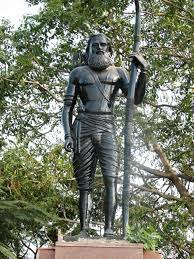Indian History
Alluri Sitarama Raju
- 05 Jul 2022
- 3 min read
For Prelims: Modern History, Mahatma Gandhi, non-Cooperation Movement
For Mains: Alluri Sitarama Raju and his contribution in Freedom Movement
Why in News?
Prime Minister has unveiled a bronze statue of Alluri Sitharama Raju in Andhra Pradesh to celebrate 125th birth anniversary on 4th July 2022.
- As part of Azadi Ka Amrit Mahotsav, Government is giving due recognition to the contribution of freedom fighters and making people across the country aware of them.
Who Was Alluri Sitarama Raju?
- About:
- He was an Indian revolutionary involved in the Indian independence movement.
- He was born in present-day Andhra Pradesh in 1897 or 1898.
- He became a sanyasi at the age of 18, and gained a mystical aura among the hill and tribal peoples with his austerity, knowledge of astrology and medicine, and his ability to tame wild animals.
- Freedom Movement:
- At a very young age, Raju channelled the discontent of the hill people in Ganjam, Visakhapatnam, and Godavari into a highly effective guerrilla resistance against the British.
- Guerrilla warfare is a form of irregular warfare in which small groups of combatants use military tactics including ambushes, sabotage, raids, petty warfare, hit-and-run tactics, and mobility, to fight a larger and less-mobile traditional military.
- Colonial rule threatened the tribals’ traditional podu (shifting) cultivation, as the government sought to secure forest lands.
- He became involved in anti-British activities in response to the 1882 Madras Forest Act, which effectively restricted the free movement of Adivasis (tribal communities) in their forest habitats and prevented them from practicing a traditional form of agriculture known as podu (shifting cultivation).
- Rising discontent towards the British led to the Rampa Rebellion/Manyam Rebellion of 1922, in which he played a major part as a leader.
- The Rampa Rebellion coincided with Mahatma Gandhi’s Non-Cooperation Movement. He persuaded people to wear khadi and give up drinking.
- But at the same time, he asserted that India could be liberated only by the use of force, not non-violence.
- He was nicknamed "Manyam Veerudu" (Hero of the Jungle) by local villagers for his heroic exploits.
- In 1924, Raju was taken into police custody, tied to a tree, and shot by a public execution, effectively ending the armed rebellion.
- At a very young age, Raju channelled the discontent of the hill people in Ganjam, Visakhapatnam, and Godavari into a highly effective guerrilla resistance against the British.





